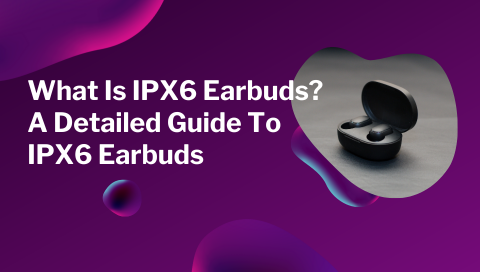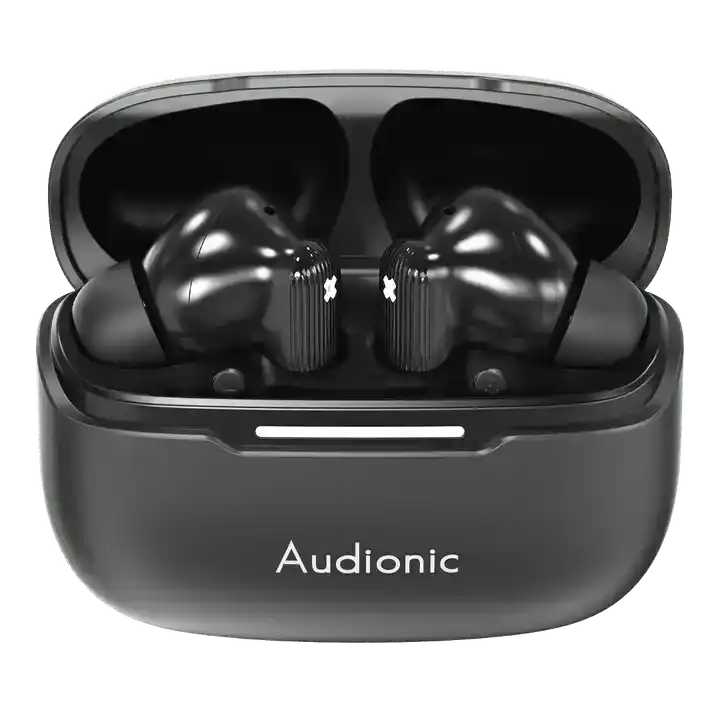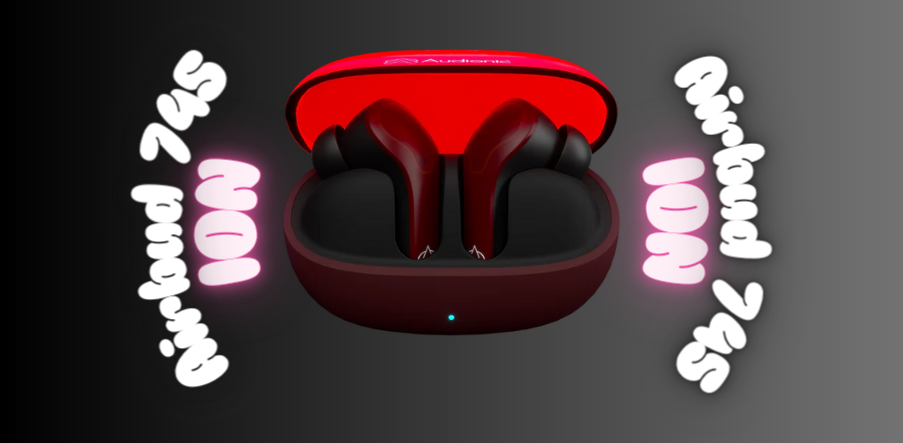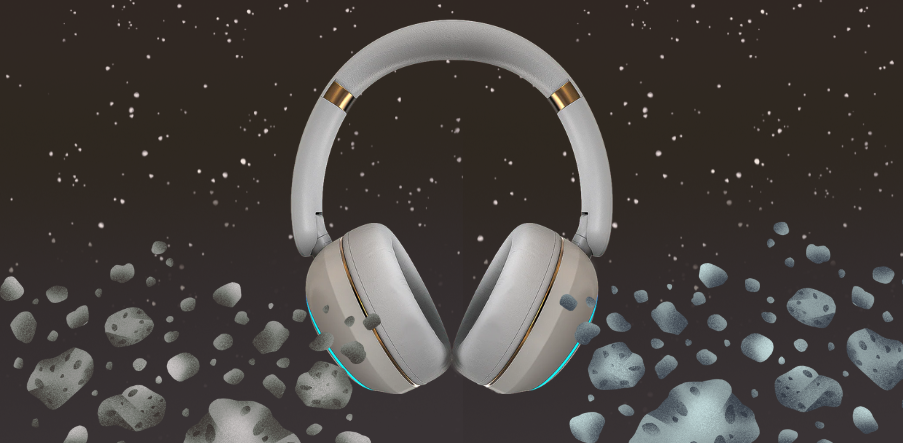
What Is IPX6 Earbuds? Here's Your Go-To Guide for Waterproof IPX6 Earbuds!
Have you ever come across the term "IPX6" when shopping for wireless earbuds and wondered what in the world it means? You're not alone. It's one of those techy-sounding acronyms that can leave you scratching your head.
But fear not, because in this detailed guide, we're going to unravel the mystery of IPX6 earbuds. We'll break it down in a way that's easy to understand, so you can make informed decisions when choosing the perfect pair of earbuds for your active lifestyle.
Think of this as your friendly crash course in all things IPX6. We'll explore what IPX6 actually means, why it matters when it comes to earbuds, and how it can make a world of difference in your daily life.
So, whether you're a fitness enthusiast looking for sweat-proof earbuds or just someone who wants reliable audio gear for everyday adventures, keep reading. By the end of this guide, you'll be an IPX6 earbuds expert, ready to make the best choice for your needs. Let's get started!
Is IPX6 Rating Good For Earbuds?
You know, IPX6 technology is pretty awesome when it comes to earbuds. It's like a superpower that lets them handle heavy rain, splashes, and even water jets without breaking a sweat.
So, what's the deal with these IPX6-rated earbuds? Well, they're basically the superheroes of the earbud world when it comes to dealing with water or moisture. They're like that trusty umbrella you grab when it starts drizzling. But here's the thing, they're not meant for deep-sea adventures – no underwater concerts or swimming with these buds, unfortunately.
These IPX6-rated earbuds are perfect for folks who love to get their sweat on during workouts, brave the great outdoors in rainy weather, or just find themselves in situations where a random water splash might happen. They've got your back in those scenarios.
So, whether you're a fitness guru hitting the gym, an outdoor enthusiast hiking in unpredictable weather, or just someone who likes to dance in the rain (with some good tunes, of course), IPX6-rated earbuds might be your ideal audio companions.
Is IPX6 Fully Waterproof?
You see, that "6" in IPX6, it's like a secret code for how good these earbuds are at handling water. Specifically, it means they're tough enough to handle powerful water jets. Picture a high-pressure water hose at a distance of about three meters – that's the kind of challenge these earbuds are up for.
In plain English, it means you can take these bad boys out in some serious rain, deal with splashes like a champ, and even brave those direct water jets without worrying about them throwing in the towel.
But, and here's the catch, don't get any wild ideas about taking these earbuds for a swim or treating them to an underwater adventure. They're not built for that kind of deep dive. Instead, think of them as your trusty sidekick for those moments when you might catch a bit of unexpected rain or a surprise water splash.
So, if you're all about enjoying the great outdoors or just living life to the fullest, these IPX6-rated earbuds have got your back, ready to face the elements without missing a beat.
Which Is Better IPX6 Or IPX7?
Of course, let's make this choice between IPX6 and IPX7 feel like picking the perfect outfit for the day:
Alright, when it comes to choosing between IPX6 and IPX7, it's a bit like deciding what shoes to wear for different occasions. It all boils down to your needs and how you plan to use your device. Neither one is the ultimate winner; they just bring different skills to the table, like superheroes with unique powers.
Now, picture this as a friendly fashion show between IPX6 and IPX7:
IPX6 (Water-Resistant to Powerful Jets of Water)
So, here's the deal with IPX6-rated devices – they're like the superheroes of water resistance, capable of handling those heavy-duty water jets, like when you're caught in a downpour or facing some enthusiastic water splashes. You can think of them as your trusty sidekick for outdoor adventures, like running in the rain or simply rocking out with your earbuds in wet conditions.
But, and this is a pretty important "but," they're not built for those underwater escapades. So, while they might survive a quick dip or a splash here and there, don't plan on having them as your swimming buddies or submerging them for extended periods. These devices are more about handling the occasional splash, not performing deep-sea missions.
So, if you're all about living an active life and want gadgets that can keep up with your adventures, IPX6-rated devices are your go-to. Just remember to keep them above water for the best results!
IPX7 (Waterproof, Immersion up to 1 Meter)
Alright, IPX7-rated devices are like the waterproof champs of the tech world. They can take a dive in water up to 1 meter deep for a short stint, usually around 30 minutes. Think swimming, snorkeling, or situations where your gear might take a brief underwater plunge.
Compared to IPX6, they're like the superheroes with capes. So, if you're planning on some serious water adventures where your gear might go for a swim, IPX7-rated devices are your best bet. But, if you're more about rain, sweat, or the occasional splash, IPX6-rated gear should do just fine. Keep it simple, right?
Which Is Better IPX5 Or IPX6
IPX5 (Water-Resistant to Water Jets)IPX5-rated devices are like your trusty umbrella in a rainstorm. They can handle water jets with a 6.3 mm nozzle, pumping out 12.5 liters per minute from 3 meters away.
So, if you're into outdoor workouts and need gear that can brave the rain, shield against hefty splashes, and deal with your sweat like a pro, IPX5 is your jam. But remember, they're not up for a full-on underwater adventure or any extended water dips. Keep 'em dry when it comes to deep water!.
IPX6 (Water-Resistant to Powerful Jets of Water)Alright, IPX6-rated devices are like heavy-duty defenders against water. They can handle supercharged water jets, coming at them from a 12.5 mm nozzle, and pumping out 100 liters per minute from a distance of 3 meters. That's some serious water action!
So, if you're all about braving heavy rain, putting up with fierce water splashes, or even facing off against intense water pressure, IPX6 is your go-to. But, just like IPX5, don't even think about dunking these devices underwater for a swim – they're not built for it.
In a nutshell, IPX6 takes things up a notch compared to IPX5, making it perfect for situations with even stronger water exposure, like those torrential downpours or water jets that mean business.
Can You Shower With IPX6 Earbuds?
Alright, here's the scoop – you can totally rock your IPX6 earbuds in the shower. These IP-rated champs are built to handle heavy rain, so a shower is a breeze for them. No need to worry about a little water.
But here's a little heads-up: watch out for the stuff you're using in the shower, like shampoo or body wash. Sometimes, these products can be a bit sneaky and leave residue on your earbuds. Over time, that buildup might lead to some technical hiccups. So, while your IPX6 earbuds can handle the water, they're not big fans of chemicals. Just be mindful of what you're using, and you'll be jamming to tunes in the shower like a pro!
What Is The Difference Between IPX6 And IP6x?
IPX6 and IP6X are two different ratings that serve entirely distinct purposes and are used to assess different aspects of electronic devices, so they should not be confused with each other. Here's the difference between IPX6 and IP6X:
IPX6The "X" in IPX is a placeholder for the dust protection rating (since dust protection is not considered in the IPX rating), and the number that follows (e.g., IPX6) indicates the water resistance of the device.
IPX6 specifically indicates that the device is water-resistant and can withstand powerful jets of water, typically from a nozzle with a diameter of 12.5 mm, at a flow rate of 100 liters per minute, from a distance of 3 meters.
It is a rating related to water resistance.
IP6XIP6X is a rating that pertains to dust resistance.
It is not related to water resistance but rather indicates the level of protection against the intrusion of dust and particulate matter into a device.
An IP6X rating means that the device is dust-tight, and it should not allow any solid particles, including dust and sand, to enter its enclosure.
This rating is often used for devices that need to be protected from dust and fine particles that could affect their operation or performance.
In summary, IPX6 relates to water resistance, indicating that a device can withstand water exposure, while IP6X relates to dust resistance, indicating that a device is protected against dust and solid particle ingress.
These ratings are independent of each other and serve different purposes in assessing a device's environmental protection capabilities.
Is IPX5 Good For Rain?
Yes, IPX5-rated devices can withstand rain and heavy sweat. It can even handle direct splashes of water.
Is IPX7 Fully Waterproof?
IPX7 is not fully waterproof but rather strongly resistant to water.
An IPX7-rated device is designed to withstand water immersion up to 1 meter (approximately 3.3 feet) in depth for a short period, typically around 30 minutes.
The "7" in the IPX7 rating specifically denotes the device's ability to be submerged in water without suffering damage.
IPX7-rated devices are capable of being submerged in water up to a depth of 1 meter (approximately 3.3 feet) for a limited duration.
This immersion can typically be sustained for approximately 30 minutes without causing significant damage or affecting the device's functionality.
Because of these features, IPX7 is often used for waterproof electronic devices such as waterproof speakers, some types of headphones, and certain smartphones that are designed to withstand brief submersion in water.
It's also suitable for activities like swimming, snorkeling, or using devices in wet conditions.
Let’s Conclude With A Question, Can You Swim With IP67 Earbuds?
You're probably excited about the idea of taking your IP67 earbuds for a swim. After all, IP67 sounds pretty impressive in the world of water-resistant gadgets. But, as with any tech-related question, the devil is in the details.
First things first, what's that IP67 rating all about? Well, it means your earbuds are dust-tight (the "6" part) and can handle immersion in water up to 1 meter deep for 30 minutes (the "7" part). That's quite the feat!
Now, here's the crucial distinction: IP67 can withstand immersion, but it's not designed for prolonged underwater adventures. In other words, your IP67 earbuds are like water-resistant superheroes, but they're not mermaids. 🧜♂️
So, while you can confidently wear your IP67 earbuds in the rain or during a sweaty workout without breaking a sweat yourself, swimming is a bit of a different story. Here's why:
- Water Pressure
- Chemicals — Pools often have chlorine, and saltwater swimming in the ocean comes with its own set of challenges. These chemicals can potentially affect the seals and components of your earbuds over time.
- Forceful Movement
That said, some folks do take the risk and use IP67 earbuds for swimming without any issues. But here's the big disclaimer: it's a gamble. Your earbuds might survive a few swims, or they might not. It depends on factors like the quality of the earbuds, how well they've been sealed, and how they handle the specific conditions of your swim.
If you're really keen on having earbuds for swimming, you might want to consider earbuds with a higher water resistance rating, like IPX7 or even specialized waterproof models. These are designed to handle prolonged submersion and the challenges of aquatic activities.
So, in summary, while IP67 earbuds are tough cookies when it comes to water resistance, swimming with them is a bit like playing musical roulette. It's doable, but you might want to think twice before making them your go-to swim buddies.



















